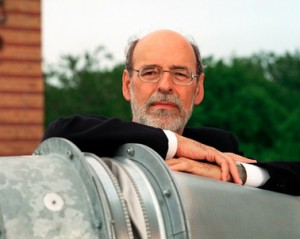A solution to the global financial crisis may be in the hands of economists – notably those like Carlo Jaeger of the Potsdam Institute for Climate Impact Research (PIK) – who are embracing a bold economic model designed around green growth.
Jaeger, who has a joint appointment at the University of Potsdam and chairs the European Climate Forum, is at Arizona State University this winter as the Julie Wrigley Visiting Senior Scholar at the School of Sustainability. He has been interacting with ASU sustainability scientists, faculty members and students to discuss research on how a green growth strategy to address the global financial crisis can bring about transformational changes.
“Green growth, in my view, is an economic dynamic by which you get higher growth than you would have otherwise and with fewer emissions,” explained Jaeger.
“The experience of the global financial crisis shows that the existing economic models were seriously limited. Against this background, a fundamental overhaul of European climate policy models is required,” wrote Jaeger and other co-authors of the 2011 study “A New Growth Path for Europe.” The study, commissioned by the German Federal Ministry for the Environment, Nature Conservation and Nuclear Safety, asserted that to identify and assess options for climate policy, models are needed “that meet the challenges exposed by the financial crisis.”
“For example, the models that were state-of-the-art before the crisis assumed that economic systems have a single stable equilibrium. Studies based on this kind of model imply that reducing greenhouse gas emissions creates extra costs in the coming years in order to avoid damages in the distant future – thereby win-win strategies are excluded by construction,” noted the report.
“A key problem of climate policy is, however, to balance the short-term view of businesses with the much longer-term view required by policy-makers aware of climate change. The financial crisis has exposed the fact that different expectations can lead to different investment behaviors, turning those expectations into sell-fulfilling prophecies,” wrote Jaeger and the co-authors. “Research has now started to take this into account in models used for policy advice.”
In a column published on the online Economists’ Forum of the Financial Times last fall, Jaeger focused on European financial instability. “Public debt is not the cause of financial turmoil in the eurozone,” he wrote
“What happened in Europe was that countries in its industrial core achieved massive export surpluses by combining high labour productivity with stagnant wages. The resulting revenues led to huge capital flows into peripheral countries that at the same time experienced matching export deficits. In the financial crisis, these capital flows came to a sudden stop,” he noted in the Oct. 24, 2011, column.
“Potential investors saw insufficient demand for the products of entrepreneurial investments and preferred to park their money at near-zero interest rates.”
A solution, according to Jaeger, is a green growth strategy. In his column he argued: “Potential investors must be faced with the prospect of sustainable growth and robust demand for their products. Retrofitting the built environment, building new power grids for renewable energy, renewing Mediterranean forests, developing new transport systems – these are examples of the initiatives that can turn the animal spirits of investors around.”
While he acknowledged that his work started in Europe, Jaeger is also looking at what transformational strategies would look like in America.
“The financial crisis has been handled to avoid disaster, but now we have serious unemployment and insufficient growth. The need for transformational changes is high in America and I hope ASU can play a leading role in a strategy to fix this current predicament,” Jaeger said.
During one of his lectures on ASU’s Tempe campus titled “Global Financial Crisis: is Green Growth the Answer?” Jaeger said it is possible in five years to turn the government deficit into a surplus, “if you have high growth.”
“But we do not have high growth. So, what needs to be done, is first to get the economy growing again. I’m arguing that with a green growth agenda you can focus investors’ minds on the line of investment where there are opportunities, where there is a need, and once you get growth going, then you reduce the deficit,” he said.
“But, trying to do this the other way around means we stay in a slump for a long time,” said Jaeger, who acknowledged there is much ongoing work in constructing new models in climate economics, which are built on existing models.
“It is crucial to take an existing model and modify it so we can study key aspects of desirable changes,” said Jaeger, who has a doctorate in economics from Goethe University in Frankfort, Germany, and a master’s degree in sociology from the University of Bern.
“Carlo Jaeger is a true visionary who has developed this very interesting model about how in this century we could change our environment and our society worldwide into a sustainable and more equitable one,” said Sander van der Leeuw, dean of ASU’s School of Sustainability
“His model is having considerable impact in Germany and in Europe more widely,” said van der Leeuw. “While at ASU, Professor Jaeger has met with faculty and students and presented a series of lectures on global system dynamics and policy. He is one of two senior fellows we have at ASU this year to engage with our sustainability scholars and students.” The other is Wallace “Wally” Broecker, the Newberry Professor of Earth and Environmental Sciences at Lamont-Doherty Earth Observatory at Columbia.
Carol Hughes, carol.hughes@asu.edu
480-965-6375
